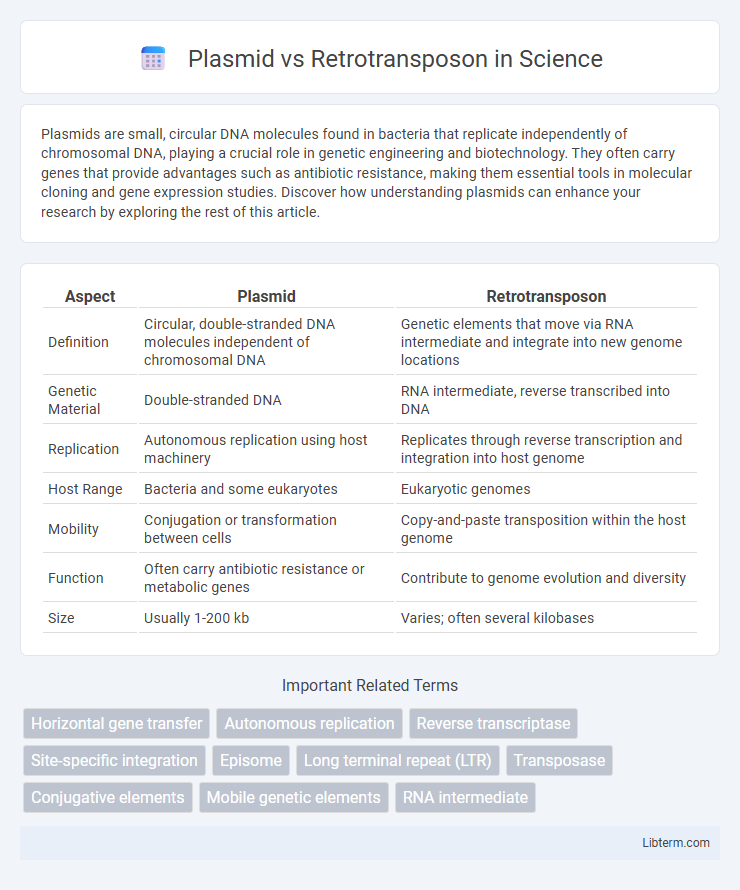Plasmids are small, circular DNA molecules found in bacteria that replicate independently of chromosomal DNA, playing a crucial role in genetic engineering and biotechnology. They often carry genes that provide advantages such as antibiotic resistance, making them essential tools in molecular cloning and gene expression studies. Discover how understanding plasmids can enhance your research by exploring the rest of this article.
Table of Comparison
| Aspect | Plasmid | Retrotransposon |
|---|---|---|
| Definition | Circular, double-stranded DNA molecules independent of chromosomal DNA | Genetic elements that move via RNA intermediate and integrate into new genome locations |
| Genetic Material | Double-stranded DNA | RNA intermediate, reverse transcribed into DNA |
| Replication | Autonomous replication using host machinery | Replicates through reverse transcription and integration into host genome |
| Host Range | Bacteria and some eukaryotes | Eukaryotic genomes |
| Mobility | Conjugation or transformation between cells | Copy-and-paste transposition within the host genome |
| Function | Often carry antibiotic resistance or metabolic genes | Contribute to genome evolution and diversity |
| Size | Usually 1-200 kb | Varies; often several kilobases |
Introduction to Plasmids and Retrotransposons
Plasmids are small, circular DNA molecules that replicate independently within bacterial cells and often carry genes beneficial for survival, such as antibiotic resistance. Retrotransposons are genetic elements that transpose via an RNA intermediate, inserting copies of themselves into new locations within the host genome through reverse transcription. Both play crucial roles in genetic variation and horizontal gene transfer but differ fundamentally in structure, replication mechanisms, and cellular context.
Defining Plasmids: Structure and Function
Plasmids are circular, double-stranded DNA molecules that replicate independently within bacterial cells, often carrying genes responsible for antibiotic resistance and metabolic functions. Unlike retrotransposons, plasmids exist as extrachromosomal elements, facilitating horizontal gene transfer through conjugation. Their autonomous replication and gene-carrying capacity make plasmids crucial tools in genetic engineering and biotechnology.
Retrotransposons: Mechanisms and Characteristics
Retrotransposons are genetic elements that replicate via an RNA intermediate using a "copy-and-paste" mechanism facilitated by reverse transcriptase, integrating new copies into the host genome. They are classified into two main types: long terminal repeat (LTR) retrotransposons, which resemble retroviruses, and non-LTR retrotransposons, which lack LTRs and use target-primed reverse transcription. These elements contribute to genome evolution and diversity by causing insertions, deletions, and rearrangements, often impacting gene expression and genome stability.
Origins and Evolutionary Significance
Plasmids are extrachromosomal DNA molecules that originate primarily in bacteria, facilitating horizontal gene transfer and contributing to rapid adaptation and antibiotic resistance evolution. Retrotransposons, derived from ancient viral elements, are mobile genetic sequences within eukaryotic genomes that propagate via RNA intermediates, driving genomic diversity and shaping evolutionary trajectories. Both plasmids and retrotransposons serve as key players in genetic innovation and genome plasticity across different domains of life.
Modes of Replication and Mobility
Plasmids replicate autonomously through a theta or rolling-circle mechanism, enabling rapid copying within bacterial cells, while retrotransposons replicate via an RNA intermediate that undergoes reverse transcription to integrate into new genomic locations. Plasmids exhibit horizontal gene transfer primarily through conjugation, allowing movement between cells, whereas retrotransposons utilize a "copy-and-paste" mechanism for mobility within the host genome but lack intercellular transfer capability. The distinct replication modes of plasmids and retrotransposons reflect their roles, with plasmids facilitating genetic exchange and retrotransposons contributing to genome plasticity.
Roles in Genetic Variation and Adaptation
Plasmids play a crucial role in genetic variation by facilitating horizontal gene transfer among bacteria, enabling rapid adaptation to environmental stresses such as antibiotic exposure. Retrotransposons contribute to genome plasticity in eukaryotes by inserting themselves into new genomic locations, generating mutations and regulatory changes that drive evolutionary innovation. Both elements enhance genetic diversity, with plasmids primarily affecting prokaryotic populations and retrotransposons influencing eukaryotic genome dynamics.
Impact on Genome Structure and Integrity
Plasmids, as extrachromosomal DNA elements, contribute to horizontal gene transfer, enhancing genetic diversity without directly disrupting chromosomal integrity, whereas retrotransposons integrate into the genome via RNA intermediates, potentially causing insertional mutagenesis and genome instability. Retrotransposons can increase genome size and induce chromosomal rearrangements through their copy-and-paste replication mechanism, impacting genome architecture significantly. The dynamic activity of retrotransposons contrasts with the typically stable maintenance of plasmids, influencing genome evolution and structural variation.
Applications in Genetic Engineering and Biotechnology
Plasmids serve as essential vectors for gene cloning, expression, and recombinant protein production due to their ability to replicate independently in bacterial hosts. Retrotransposons, while not commonly used as direct tools, offer insights into genome evolution and can be engineered for insertional mutagenesis and gene tagging in functional genomics. Plasmids dominate biotechnology applications with their ease of manipulation and transfer, whereas retrotransposons contribute to understanding transposable element dynamics and genome plasticity.
Key Differences: Plasmid vs Retrotransposon
Plasmids are circular, double-stranded DNA molecules that replicate independently within bacterial cells, often carrying genes beneficial for antibiotic resistance or metabolism. Retrotransposons are genetic elements found in eukaryotic genomes that replicate via an RNA intermediate and integrate back into the genome through reverse transcription. Unlike plasmids, retrotransposons do not exist independently but are part of chromosomal DNA and contribute to genome evolution and variability.
Future Perspectives and Research Directions
Future research on plasmids and retrotransposons is focused on their roles in genetic engineering and gene therapy, aiming to enhance their delivery efficiency and target specificity. Advances in CRISPR-Cas systems integrated with plasmid vectors or retrotransposon elements hold promise for precise genome editing applications. Investigations into the evolutionary impact and horizontal gene transfer mechanisms of plasmids and retrotransposons will deepen understanding of their contributions to genetic diversity and adaptability.
Plasmid Infographic

 libterm.com
libterm.com